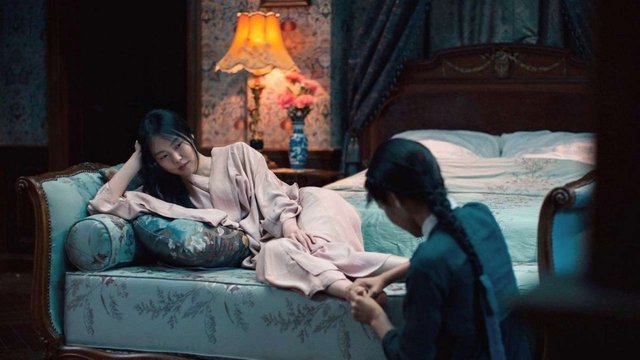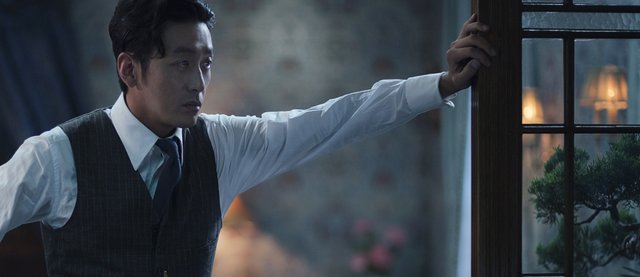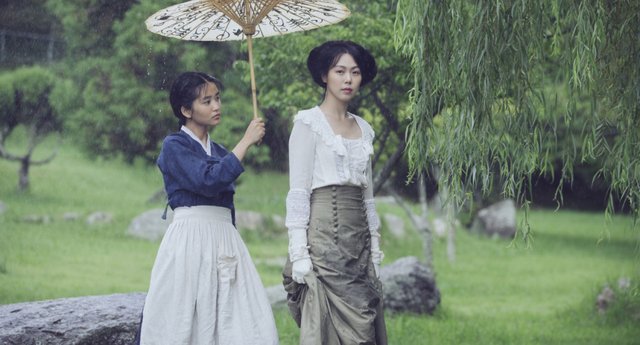/ Film Class #21 / The Handmaiden / Chan-wook Park

Park Chan-wook, best known for his Revenge Trilogy (Sympathy for Mr. Vengeance (2002), Oldboy (2003), and Lady Vengeance (2005)), returns to an international scene with style, inspired by the story of the historic novel Fingersmith, by Wisconsin writer Sarah Waters, who adopts but also questions the Victorian novel's strategy.
The Handmaiden represents the fusion of the various phases of Park's career and various authorial signatures he has developed during his career: from his striking visual poetry to his mix between something distinctive Korean and something obviously Western.
Park’s adaptation, co-written with Chung Seo-kyung, retains the novel’s structure, but places it in a closer context, so Victorian Britain replaces Korea under the colonial government of Japan in the 1930's.
Acording to Indie Wire, at first Park thought to shoot an English-language, Victorian-era film, until he discovered that the BBC had already done one. That’s when he decided to not only produce a Korean version set during the Japanese occupation, but also to alter the book, which had soap-opera elements, to meet his own reader’s desire of where he wanted the plot to go. These changes allowed him “to not only get the element of different classes, servants and aristocrats,” Park said, “but you get the added layer of the backdrop of a society being under colonial rule.”
PLOTLINE:
(1) (source: Deep Focus Review, link below)
The film has a three act structure in the Rashomon sense, meaning at a certain point we definitively reset the story. In the first part, the story involves an elaborate fraud in which a seasoned Korean con man (Ha Jung-woo) poses as a Japanese aristocrat named Count Fujiwara. Under his alternate identity, Fujiwara plans to seduce Hideko (Kim Min-hee), a Japanese heiress living with her Korean uncle Kouzuki (Cho Jin-woong), a rich book collector secluded in an impressive estate. Although Kouzuki intends to marry his privileged niece, Fujiwara arranges the lowly pickpocket Tamako (Kim Tae-ri) to serve as Hideko’s handmaiden under the name Sookee. Having come from a gang of thieves, the newly named Sookee has been tasked with convincing Hideko to fall for Fujiwara, instead of her uncle, which is no stretch.
Meanwhile, Hideko seems naïve, raised in isolation under the rigid tutelage of her uncle. She needs Sookee and clings to her, relying on her for advice on how to deal with Fujiwara courting her, as he remains on the estate under the auspices of teaching Hideko how to paint. But then, there’s far more to Hideko than her outwardly untried quality.
At the same time, Sookee begins to fall for her mark. She and Hideko begin a passionate association, which must be kept under wraps given Hideko’s planned marriage to her uncle, as well as the conspired coupling with Fujiwara. Over the course of the film, Park gradually unveils the true nature of his characters, each of whom occupies multiple layers of predatory deception, secrecy, and desire.

ANALISYS
What first strikes the viewer is extremely stylish and lavish atmosphere of the film, whose emphasis on rich magnificent estates very successfully combines Japanese and Victorian tradition. The space is demandingly designed: at the same time large and forever closed, with a special arrangement of rooms and unusually prominent details (such as a cherry tree in the courtyard or a cobra at the entrance to the library). The above brings a strong psychological note in the perception of the viewer, but also in the behavior of the characters, so Sook-hee at one point asks herself whether the unhealthy mental state of the young Hideke was caused by the property on which she was detained. Irony and even black humor (as a continuous leitmotif of the directors poetics) rests on the wealth of a heiress who has no ability and strength to express herself, so grandiose dressing and countless pairs of precious shoes can walk only within the boundaries imposed by her cruel uncle.
''Critics have described The Handmaiden as Park’s first attempt at realism. That’s partly right — at least compared to his previous films, which have featured vampires, extremely successful hypnosis, and impossibly neoliberal private prisons in which a person can pay to imprison his enemies. But Park applies to his new theme a similarly fantasy-driven sensitivity and lens. The Handmaiden depends on miracles: the miracles of erudition and the equally miraculous autonomy of a person’s desires and pleasures. In Oldboy, an imprisoned man shadowboxes for 15 years and eventually turns himself into a master fighter. The Handmaiden is animated by a similar dream of abstract, easily recontextualized learning, though the object of study here is not fighting, but sex. On the one hand, it depicts sex as something that requires artifice and extended instruction; on the other, it insists that such instruction cannot control or constrain the uses to which such carefully acquired skills will be put.'' (2)
Park offers his vision of love and sexuality. Count Fujiwara does not want to use Hideko, he wants her to fall in love with him. Its not an intimate relationship, if she doesn't feel attractiveness and affection. In Stoker, Park has already played with sexuality but somewhat reserved. In "The Handmaiden" he went a step further. Several scenes in the film abound with nakedness, but it does not seem volatile.

What is interesting is that the male sexuality is in comparison to the eroticism and warmth of the two women is cold and almost grotesque. It's because Chan Wook is using the theme of sexuality as a tool of oppression. Men are portrayed as unwanted voyeurs who doesn't understand women.
“Tell me, what is it that men want, at night?” Hideko asks with innocence at one point in the film.
Both Kim Tae-ri and Kim Min-hee are two powerfull and inteligent women, and at the beginning of the film they both still believe that accepting the manipulations of men is the best that they can strive for, but as the film progresses they realize that maybe freedom is possible.
''There was concern that it's something Kineku has read during a reading session, and when she's overcome a lot of obstacles with Sook-hee, and when she's liberated herself from that male oppression, why does she have to act out something she was forced to read from this erotic literature? But that was my very point. If she uses what she had to read by force, for the reading pleasure of these male guests - if she uses that for her own pleasure, then I thought it would emphasise the subversive nature of the film. '' (Chan Wook Park)
COSTUME
Video Essay | The Handmaiden: Why costume design is important
Natalie Ng talks about how costume design can add more layers to a film's storytelling and looks at the specific use of gloves in the film:

LA Times wrote : ''Without sacrificing his taste for psychosexual perversity or his flair for violent grace notes, Park has given us a teasingly witty and elegant puzzle-box of a thriller whose pleasures are rooted not in visceral shock but in narrative surprise, and which wisely opts to seduce rather than pulverize its audience.''
(1) Deep Focus Review, http://deepfocusreview.com/reviews/the-handmaiden/
(2) “The Handmaiden”’s Ars Erotica, by Marta Figlerowicz
Post of the day.i resteem it
@cryptomaker
thank you so much!
ohh great post reading it takes time lol but i m gonna read it :)
@bibkchhetri
hahaha well, hope you'll enjoy it!
interesting story..!
This is probably one of my very first comments on your posts. I am glad that I read and thoroughly enjoyed this post. Very well-written.
Keep up the good work and support for the Steemit community.
Steem on!